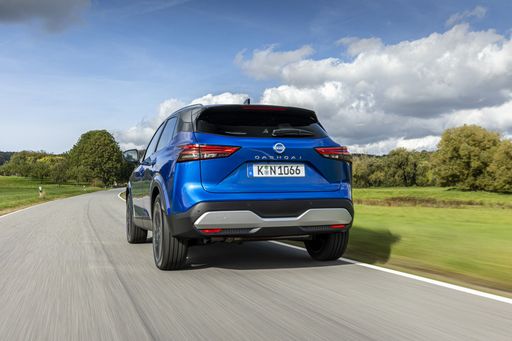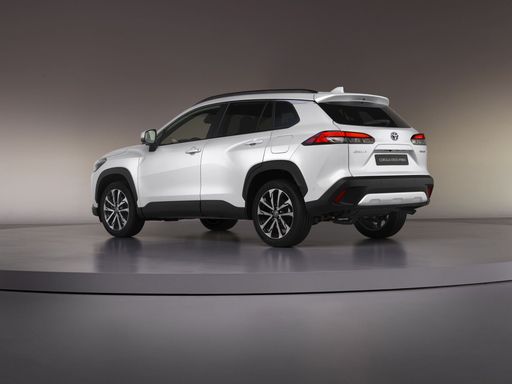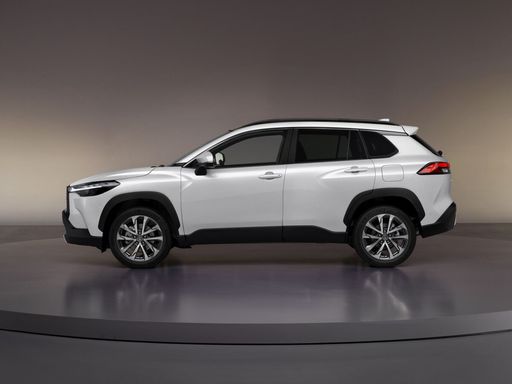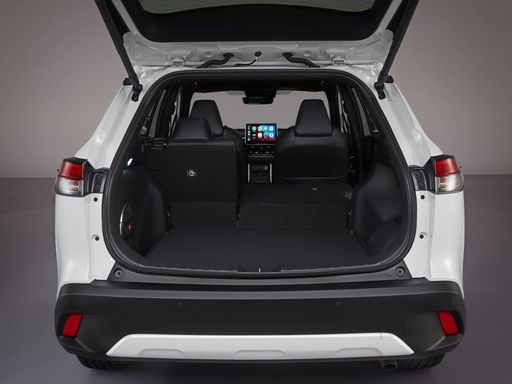As the world of automobiles continues to evolve, compact SUVs are becoming increasingly popular among consumers. Two formidable contenders in this segment are the Nissan Qashqai and the Toyota Corolla Cross. Both models bring a range of features, styles, and innovations to the table, appealing to a diverse audience. This article aims to compare these two SUVs across various technical aspects and innovations, helping potential buyers make an informed decision.
Nissan Qashqai vs Toyota Corolla Cross – Performance, range & efficiency compared
Two cars, one duel: Nissan Qashqai meets Toyota Corolla Cross.
Which one wins in performance, efficiency and value for money? Find out now!
Design and Dimensions
The Nissan Qashqai boasts a sporty and modern design, measuring 4425 mm in length, 1835 mm in width, and standing 1625 mm tall. Its distinctive V-Motion grille and boomerang-shaped headlights enhance its bold exterior. On the other hand, the Toyota Corolla Cross is slightly larger at 4460 mm in length and 1825 mm in width, while also featuring a height of 1620 mm. The Corolla Cross maintains a more conventional SUV stance, emphasizing a practical and family-friendly appearance.
Engine Options and Performance
The Nissan Qashqai offers a variety of engine options, including petrol mild hybrid and full hybrid configurations with power outputs ranging from 140 HP to a robust 190 HP. Noteworthy is its fuel consumption, which ranges between 5.1 to 6.8 L/100 km, making it efficient for daily use. Acceleration from 0 to 100 km/h can be achieved in as little as 7.9 seconds, depending on the engine choice.
In contrast, the Toyota Corolla Cross is equipped with a full hybrid powertrain, providing two power variants: 140 HP and 197 HP. Its fuel efficiency is impressive as well, with consumption figures between 5.1 to 5.3 L/100 km. The acceleration capabilities of the Corolla Cross are equally remarkable, reaching 100 km/h in as little as 7.6 seconds in its more powerful variants.
Transmission and Drive Systems
Both vehicles offer an automatic transmission option, with the Nissan Qashqai featuring a smooth CVT alongside a manual gearbox option for purists. It supports both front-wheel drive and all-wheel drive configurations, providing versatility in different driving conditions.
Likewise, the Toyota Corolla Cross offers an automatic transmission with CVT and is available in both front-wheel drive and all-wheel drive versions. This setup ensures a comfortable driving experience across varying terrains.
Interior Space and Comfort
When it comes to trunk capacity, the Qashqai shines with its spacious 504-liter trunk, making it ideal for family outings and road trips. The cabin is designed with a focus on comfort, providing ample legroom and high-quality materials throughout the interior.
The Toyota Corolla Cross offers a slightly smaller trunk capacity, ranging from 414 to 425 liters, but it still provides a functional space for cargo. Like the Qashqai, the Corolla Cross emphasizes passenger comfort, featuring a well-appointed interior with useful technology integrated throughout.
Safety and Technology Innovations
Safety is paramount in both vehicles. The Nissan Qashqai is equipped with advanced driver assistance systems, enhancing collision avoidance and overall safety. Features such as blind-spot monitoring, lane departure warning, and adaptive cruise control are tailored to provide peace of mind on the road.
The Toyota Corolla Cross is no slouch either, boasting its own suite of safety features under the Toyota Safety Sense package. With systems like pre-collision systems, lane tracing assist, and adaptive cruise control, it aims to keep all occupants safe during their travels.
Conclusion
In comparing the Nissan Qashqai and the Toyota Corolla Cross, it is clear both vehicles bring their unique strengths to the table. The Qashqai offers a more powerful engine range and a larger trunk capacity, making it a great option for families. Meanwhile, the Corolla Cross impresses with its fuel efficiency and smooth hybrid performance.
Ultimately, the choice between the two will depend on individual preferences regarding design, performance, and technological features. Whether opting for the Qashqai's sporty feel or the Corolla Cross's efficient hybrid prowess, both SUVs promise a rewarding driving experience for modern motorists.
Here’s where it gets real: The technical differences in detail
Costs and Efficiency:
When it comes to price and running costs, the biggest differences usually appear. This is often where you see which car fits your budget better in the long run.
Nissan Qashqai has a slight advantage in terms of price – it starts at 29400 £, while the Toyota Corolla Cross costs 31700 £. That’s a price difference of around 2314 £.
Fuel consumption also shows a difference: Toyota Corolla Cross manages with 4.90 L and is therefore barely noticeable more efficient than the Nissan Qashqai with 5.10 L. The difference is about 0.20 L per 100 km.
Engine and Performance:
Power, torque and acceleration say a lot about how a car feels on the road. This is where you see which model delivers more driving dynamics.
When it comes to engine power, the Nissan Qashqai has a slight edge – offering 190 HP compared to 180 HP. That’s roughly 10 HP more horsepower.
In acceleration from 0 to 100 km/h, the Toyota Corolla Cross is barely noticeable quicker – completing the sprint in 7.60 s, while the Nissan Qashqai takes 7.90 s. That’s about 0.30 s faster.
In terms of top speed, the Nissan Qashqai performs a bit better – reaching 206 km/h, while the Toyota Corolla Cross tops out at 180 km/h. The difference is around 26 km/h.
Space and Everyday Use:
Cabin size, boot volume and payload all play a role in everyday practicality. Here, comfort and flexibility make the difference.
Both vehicles offer seating for 5 people.
In curb weight, Toyota Corolla Cross is hardly perceptible lighter – 1380 kg compared to 1420 kg. The difference is around 40 kg.
In terms of boot space, the Nissan Qashqai offers to a small extent more room – 504 L compared to 425 L. That’s a difference of about 79 L.
In maximum load capacity, the Nissan Qashqai performs barely noticeable better – up to 1447 L, which is about 110 L more than the Toyota Corolla Cross.
When it comes to payload, Toyota Corolla Cross minimal takes the win – 560 kg compared to 520 kg. That’s a difference of about 40 kg.
Who comes out on top?
Overall, the Nissan Qashqai shows itself to be wins by a narrow margin and secures the title of DriveDuel Champion.
It convinces with the more balanced overall package and proves to be the more versatile choice for everyday use.
 @ Nissan Motor Corporation
@ Nissan Motor Corporation
Nissan Qashqai
Nissan Qashqai
The Nissan Qashqai blends practical, family-friendly packaging with SUV styling that refuses to shout, making it a sensible and dependable choice for everyday life. It’s comfortable to live with, economical on the road, and neatly equipped enough to feel modern without ever feeling precious — perfect if you want crossover versatility without the drama.
details @ Nissan Motor Corporation
@ Nissan Motor Corporation
 @ Nissan Motor Corporation
@ Nissan Motor Corporation
 @ Nissan Motor Corporation
@ Nissan Motor Corporation
 @ Nissan Motor Corporation
@ Nissan Motor Corporation
 @ Nissan Motor Corporation
@ Nissan Motor Corporation
Toyota Corolla Cross
The Toyota Corolla Cross takes the familiar Corolla recipe, lifts it up and dresses it in SUV clothes — sensible, comfortable and blessedly unflashy. It won’t thrill the enthusiast, but its easy manners, clever packaging and dependable feel make it an ideal everyday car for shoppers who prefer sense over sass.
details @ Toyota Motor Corporation
@ Toyota Motor Corporation
 @ Toyota Motor Corporation
@ Toyota Motor Corporation
 @ Toyota Motor Corporation
@ Toyota Motor Corporation
 @ Toyota Motor Corporation
@ Toyota Motor Corporation
 @ Toyota Motor Corporation
@ Toyota Motor Corporation
 @ Nissan Motor Corporation
@ Nissan Motor Corporation
|
 @ Toyota Motor Corporation
@ Toyota Motor Corporation
|
|
|
|
Costs and Consumption |
|
|---|---|
|
Price
29400 - 42500 £
|
Price
31700 - 41900 £
|
|
Consumption L/100km
5.1 - 6.8 L
|
Consumption L/100km
4.9 - 5.3 L
|
|
Consumption kWh/100km
-
|
Consumption kWh/100km
-
|
|
Electric Range
-
|
Electric Range
-
|
|
Battery Capacity
-
|
Battery Capacity
-
|
|
co2
116 - 154 g/km
|
co2
112 - 120 g/km
|
|
Fuel tank capacity
55 L
|
Fuel tank capacity
36 - 43 L
|
Dimensions and Body |
|
|---|---|
|
Body Type
SUV
|
Body Type
SUV
|
|
Seats
5
|
Seats
5
|
|
Doors
5
|
Doors
5
|
|
Curb weight
1420 - 1665 kg
|
Curb weight
1380 - 1500 kg
|
|
Trunk capacity
479 - 504 L
|
Trunk capacity
414 - 425 L
|
|
Length
4425 mm
|
Length
4460 mm
|
|
Width
1835 mm
|
Width
1825 mm
|
|
Height
1625 mm
|
Height
1620 mm
|
|
Max trunk capacity
1422 - 1447 L
|
Max trunk capacity
1333 - 1337 L
|
|
Payload
466 - 520 kg
|
Payload
515 - 560 kg
|
Engine and Performance |
|
|---|---|
|
Engine Type
Petrol MHEV, Full Hybrid
|
Engine Type
Full Hybrid
|
|
Transmission
Manuel, Automatic
|
Transmission
Automatic
|
|
Transmission Detail
Manual Gearbox, CVT, Reduction Gearbox
|
Transmission Detail
CVT
|
|
Drive Type
Front-Wheel Drive, All-Wheel Drive
|
Drive Type
Front-Wheel Drive, All-Wheel Drive
|
|
Power HP
140 - 190 HP
|
Power HP
140 - 180 HP
|
|
Acceleration 0-100km/h
7.9 - 10.2 s
|
Acceleration 0-100km/h
7.6 - 10 s
|
|
Max Speed
170 - 206 km/h
|
Max Speed
170 - 180 km/h
|
|
Torque
240 - 330 Nm
|
Torque
-
|
|
Number of Cylinders
3 - 4
|
Number of Cylinders
4
|
|
Power kW
103 - 140 kW
|
Power kW
103 - 132 kW
|
|
Engine capacity
1332 - 1497 cm3
|
Engine capacity
1798 - 1987 cm3
|
General |
|
|---|---|
|
Model Year
2024
|
Model Year
2025
|
|
CO2 Efficiency Class
E, D
|
CO2 Efficiency Class
C, D
|
|
Brand
Nissan
|
Brand
Toyota
|
Is the Nissan Qashqai offered with different drivetrains?
Available configurations include Front-Wheel Drive or All-Wheel Drive.
The prices and data displayed are estimates based on German list prices and may vary by country. This information is not legally binding.
